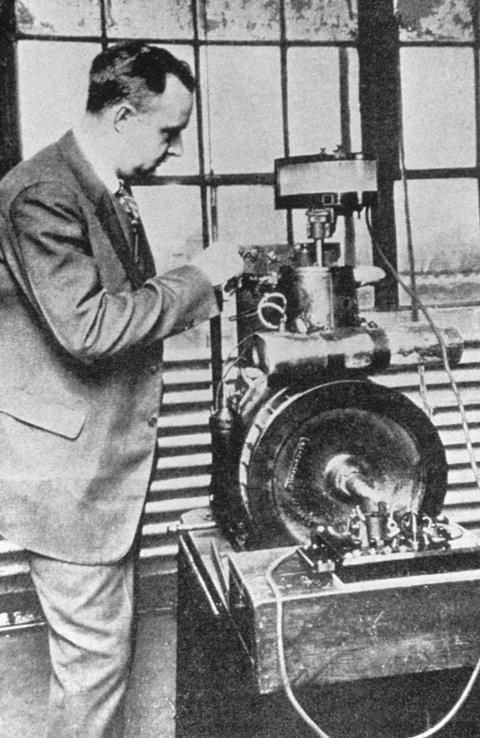Leaded petrol was around for 100 years, and the campaign against it for almost as long. Mike Sutton reveals its history
In 1921 the US automobile industry was struggling with an awkward technical problem. An internal combustion engine works best when the fuel–air mixture explodes at the optimum point in its power cycle. But premature ignition – indicated by a distinctive noise known as ‘knocking’ – reduces efficiency and damages engines. In December of that year, Thomas Midgley announced his discovery of an effective remedy for it. Midgley showed that adding traces of lead to commercial gasoline prevented knocking.
Lead’s toxicity had long been known – the Greek physician Dioscorides (c. 40–90 CE) mentioned its harmful effects in his widely-read De Materia Medica, and numerous subsequent authors observed tremors, convulsions, and madness afflicting workers in lead-based industries. Nevertheless, Midgley and his backers insisted that leaded gasoline posed no risk to public health. Decades passed before the full consequences of this error became apparent. Today, persistent lead residues remain its enduring legacy.

Midgley earned his engineering degree at Cornell University in 1911, and in 1916 joined Charles Kettering’s innovative company DELCO – shortly to become a subsidiary of General Motors. Tasked with finding a way to prevent engine knocking, Midgley at first sought an electrical fix for the ignition system. He then tried numerous fuel additives – including iodine, aniline, ethyl acetate, camphor and even melted butter – with limited success.
After the US entered the first world war in 1917, Kettering and Midgley focussed on aeroplane engines, whose high compression ratios aggravated the knocking problem. One already-known remedy was replacing a substantial proportion of the gasoline fuel with ethanol – though ethanol’s lower energy content made the engines less efficient. An alternative solution was enriching the fuel significantly with aromatic hydrocarbons – but these were relatively scarce in crude oil, and expensive to extract.
Neither of these ‘high-percentage’ additives appealed to civilian automobile producers, or to the oil industry. So, when peace returned, Midgley continued seeking a knock inhibitor that worked in trace quantities. Abandoning his earlier opportunistic approach, he worked through the periodic table, testing the efficacy of readily available elements in an engine on his laboratory bench. Several appeared promising, but lead seemed particularly potent. To blend it with the fuel, Midgely used tetra-ethyl lead – Pb(C2H5)4 – which boils around 85°C.
Knocking on the door
Midgley’s innovation was quickly patented, and General Motors and Standard Oil jointly established the Ethyl Corporation to produce and market it. They claimed that ethanol – often used in automobile fuels before the war – was an unsatisfactory alternative. However, the fact that ethanol could not be patented, nor its production controlled by a single company, also made it commercially unattractive. As Chicago patent lawyer FA Howard noted in a 1919 letter to E M Clark, the head of Standard Oil: ‘Unless the fuel producers themselves get into this work of investigating the properties of their fuels, there is a good chance that they may have to pay tribute to others […] There would be such an insistent demand for [antiknock fuel] that any oil producer who had exclusive rights could absolutely dominate the entire motor fuel market.’

After combustion, the lead left harmful deposits on sparkplugs and valves. Midgley countered this by adding ethyl bromide and chloride to the fuel, resulting in the discharge of lead halides into the environment. This was clearly a potential hazard. But although lead poisoning killed several workers at the Ethyl Corporation’s factory – and Midgley himself was temporarily incapacitated by it – he and his backers insisted that the amounts emitted by automobiles would be harmless to the public.
This claim was challenged by Alice Hamilton of Harvard Medical School, who had clinical experience with industrial lead poisoning, and by Yandell Henderson of Yale University, an expert in the physiology of respiration. Nevertheless, in 1925 a federal commission endorsed the introduction of leaded gasoline, and it became widely adopted in the US and beyond. Half a century passed before its hazards became unignorable.
Critics dismissed
In the UK, the most vocal advocate of de-leading motor fuel was Derek Bryce-Smith (1926–2011) of the University of Reading. He became concerned about heavy metal pollution while an ICI post-doctoral research fellow in the 1950s, and in 1967 he organised a conference to alert his fellow-chemists to lead’s dangers. After failing to convince them, he appealed to the news media instead. This move made him unpopular in academia. Much later, he recalled: ‘It was a very lonely battle for a very long time. A lot of my colleagues looked at me sideways, because many research chemists are in debt to the oil industry, which provides them with money for research.’
It was a very lonely battle for a very long time
A dismissive attitude towards him remained apparent at a 2015 symposium on the history of air pollution research, where Brian Commins recalled: ‘Dear old Professor Bryce-Smith caused a lot of problems for us. He had a bee in his bonnet, if you like, about lead, and justifiably. It’s not a good chemical [but we] measured lead in air in streets and the levels were quite low, being just a few micrograms per cubic metre of air… there was no firm evidence that we could identify to justify that petrol lead was a significant health issue.’
This reassuring conclusion was officially endorsed by the 1980 Lawther Report, which, as Richard Derwent recalled at the 2015 colloquium ‘…was too much for this Professor Bryce-Smith, who thought that that was a complete fudge. Unfortunately, Bryce-Smith had the media on his side, particularly the New Scientist.’
Lower IQs
Across the Atlantic, the problem was attacked by Herbert Needleman. After gaining his MD at the University of Pennsylvania in 1952 he became a paediatrician in Philadelphia, where he grew concerned about lead poisoning in infants. Its principal causes were then thought to be lead-based paints, and water supplied through lead piping. But in 1972, Needleman – now at Harvard Medical School – began investigating the possible contribution from automobile exhausts.
Testing this hypothesis seemed problematic, since the ultimate repository of ingested lead is in bones, and bone biopsies are intrusive – and painful. But Needleman collected and analysed discarded milk teeth from thousands of children, who lived in locations with differing levels of exposure to traffic fumes. Correlating this data with further information about these children’s school careers produced shocking results.
Needleman found that children in traffic-choked urban environments had lead levels up to five times higher than children in leafy suburbs. Furthermore, the average IQ scores of the more lead-exposed children were four points lower, and their educational and disciplinary records significantly worse. When his results began appearing in 1979, they aroused considerable public concern – and strong hostility from industry. The Lead Industries Association appealed to Congress to abandon or delay plans for legislation on leaded gasoline, and funded academic scientists seeking to discredit Needleman’s results.
In 1990, two university researchers requested access to Needleman’s data – ostensibly to help them defend a lead smelting company involved in a lawsuit about waste disposal. They later published a hostile critique of Needleman’s entire project, based on a few trivial errors in his statistical presentations. An academic scandal followed. Needleman was sanctioned by his university, pending an enquiry by the US government’s Office for Scientific Integrity. This eventually vindicated him, and confirmed all his main conclusions. Reflecting on the dispute, Needleman observed: ‘If this is what happens to me, what is going to happen to someone who doesn’t have tenure? I’m worried that people who are trying to get a niche and don’t have tenure are asked to do things they question the ethics of… They are intimidated. It’s a real force.’
A catalytic side-effect
Also attacked was Clair Patterson, a geochemist who had re-calculated the earth’s age by tracking the radioactive decay of uranium to lead in ancient minerals. At Caltech in the 1960s he created a pioneering ‘clean room’ environment for his meticulous analyses. These confirmed that historic industrial activity had substantially increased background lead levels, which were now being further enhanced by leaded fuel residues. Patterson – an outspoken environmentalist – attracted fierce criticism from the lead industry, and from academics whose research it funded. Nevertheless, he persisted, and his testimony to a congressional investigation gave powerful support to the campaign against leaded gasoline.

Ironically, the de-leading process was triggered by legislation that was not directly aimed at lead pollution. The US’s 1970 Clean Air Act was a response to concern about urban ‘smog’, to which automobile exhausts contributed significantly. This act compelled cars sold in the US from 1975 to have catalytic converters in their exhaust systems, in order to eliminate toxic and smog-forming gases. Since lead poisoned the platinum-based catalysts in these converters, leaded fuel had to go – though it did not depart without a struggle.
The clean air act itself was strongly opposed by the automobile industry. Beth Gardiner notes in her 2019 book Choked that ‘Chrysler bought a fullpage newspaper ad claiming ‘There is no scientific evidence showing a threat to health from automotive emissions in the normal average air you breathe.’ Lee Iacocca, by then Ford’s president, said getting rid of smog, at huge economic cost, would spare the average American just one day of coughing every 33 years.’
Initially, the act’s restrictions applied only to new vehicles. Millions of pre-1975 automobiles were expected to continue running on leaded gasoline for years. But in the 1980s, governments and the media became alarmed by further research linking childhood lead exposure with youth crime in general, and with urban rioting in particular.
This so-called ‘lead–crime hypothesis’ was challenged by some sociologists and psychiatrists, who argued that correlation did not necessarily prove causation. Nevertheless, it aroused enough concern to accelerate lead’s elimination from automobile fuel. By the 1990s most developed countries were phasing it out for road vehicles – though for a time they continued tolerating it in racing cars (this exemption ended for Formula One in 1996, but continued in the US in Nascar races until 2007). The last nation to eliminate lead from motor fuel – in July 2021 – was Algeria.
Lessons learned?
When de-leading was first proposed, industrial leaders and business-friendly think-tanks warned that it might raise fuel prices to a level which would cripple national economies. In the event, oil companies were partially protected from the change because the industry and the US government negotiated a new trading system. Oil producers who reduced their fuel’s lead content beyond the minimum legal requirement were awarded ‘lead credits’. These credits were then sold to the less efficient companies struggling to meet the new restrictions – a foretaste of the carbon trading market that has developed in response to the climate crisis.
But in the event, de-leading was accomplished with little disruption, mainly by enriching standard gasoline with ethanol; aromatic hydrocarbons were also tried, briefly, but found to carry health risks of their own. The change-over was further eased by increased sales of diesel-powered vehicles, which have other pollution issues, but do not require leaded fuel. Consumers generally found that de-leading’s effect on fuel prices at the pump was less than that of changing taxation rates, or of political upheavals in the Middle East.
But although blood levels in adults and children have since fallen significantly, a worrying legacy of lead persists in the environment. As environmentalists have pointed out, responsibility for the damage caused by lead pollution lies primarily with the companies that produced it, and the governments that permitted it. But members of the scientific community need to consider their own profession’s role in this avoidable disaster. The fierce opposition which whistle-blowers faced from cost-conscious business leaders and ill-informed government officials was predictable. But the hostility they encountered from many of their scientific peers should be remembered with embarrassment, and kept on record as a warning for future generations.
Mike Sutton is a historian of science based in Newcastle, UK













No comments yet